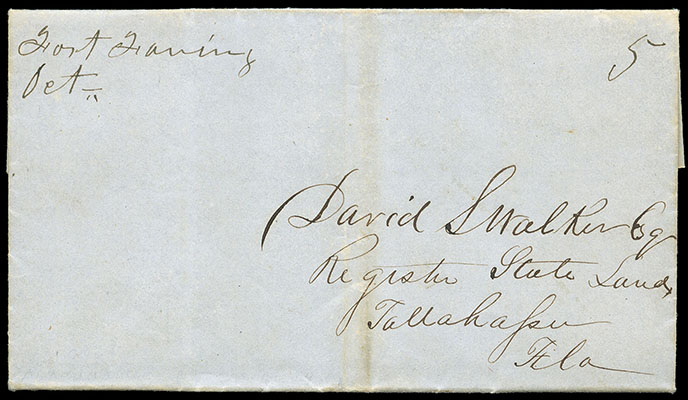
Lot
868 
"Ft. Belknap Tex., May 26/59", manuscript postmark with matching "Paid 3" rating on orange cover to Wampsville N.Y.; endorsed "Via Butterfield O.L.M." Overland Mail; reduced slightly at left, Very Fine. Estimate $200 - 300.
Fort Belknap was the northern anchor of a chain of forts founded to protect the Texas frontier from the Red River o the Rio Grande…From it troops pursued raiding band of Indians, and on occasion mounted expeditions from the fort carried the war to the enemy on the plains as far north as Kansas. Fort Belknap became the hub of a network of roads stretching in every direction, the most notable being the Butterfield Overland Mail route from St. Louis to San Francisco.
Realized: $325

Lot
869 
Fort Craig. N.M. "Aug 1", complete strike of cds with manuscript date and matching squiggle cancels 3¢ pink (U35) entire to Newport R.I.; reduced slightly at left, Very Fine strike of this desirable Territorial Fort postmark, ex-Dike. Estimate $200 - 300.
Realized: $140

Lot
870 
Fort Cummings, N.Mex. Jul 5, reddish cds duplexed with cork cancel on 3¢ green (U82) entire to Evanston Ill., Very Fine (photo on web site). Estimate $150 - 200.

Lot
871 
"Fort Dade, June the 22 1852" (Florida), manuscript postmark and matching "Paid 3 Cts" rating on blue 1852 folded letter to Tallahassee Flor., written by John W. Harrel to David Walker Esq. who wishes to file on a purchase of some land and requests an appraisal made to ascertain the value, Very Fine and rare early Fort Dade letter. Estimate $300 - 400.
Realized: $350

Lot
872 
"Fort Fanning Jany 17th 1841" (Florida), dateline on folded letter endorsed "Paid" and "Single", entered the mails with "Savannah Geo. Jan. 23" cds and matching "Paid" handstamp with magenta "25" rating to Detroit Mich., interesting letter content about Captain leaving for Palatka (post nearest Savannah) due to sickness and the horrible conditions at the post: "…Most of the Officers at the Post have had it…This is a miserable Country, in Winter it is Fever and Ague, and in Summer it is Fever of the worst kind, it is very rarely any one escapes being sick two months at a time, Those who have been in the Country any length of time look like walking ghosts…"; light stain, F.-V.F. and scarce use from the short-lived Fort Fanning. Estimate $300 - 400.
Fort Fanning, Florida was built in November 1838 during the Second Seminole War and was first called "Palmetto". Later it was renamed in honor of Colonel Alexander Campbell Wilder Fanning, who had served under General Andrew Jackson in the First Seminole War. Its purpose was to protect the highly strategic and heavily utilized crossing of the Suwannee River. It also served as a base of operations for U.S. and Florida Militia troops that tried to suppress the activities of small bands of Creek and Seminole warriors that operated from the vast swamps of the lower Suwannee River. Raids and battles were a constant part of life in the region for both whites and Indians during the years 1836-1842. The fort was garrisoned for nearly five years, during which time, 31 soldiers lost their lives, all but three of them from sickness. The post was abandoned in February 1843 and because it was made of wood and situated in a warm humid climate, it soon deteriorated.
Realized: $450

Lot
873 
"Fort Fanning, Oct -" (Florida), Type I manuscript postmark and matching "5" rating on blue folded letter datelined "Clay Landing, Oct. 2d 1851" to David Walker, Register of State Land at Tallahassee, Florida; light central fold toning, F.-V.F. and scarce postmark, The latest of only 6 recorded postmarks. Estimate $200 - 300.
Fort Fanning was an important U.S. Army post built on the Suwannee River during the Second Seminole War.
Realized: $190

Lot
874 
"Fort Gates, July 6, 1852", manuscript endorsement on buff cover entering mails with 3¢ dull red (11A), large margins to in at right, tied by partial "Pilatka Flor. Jul 8" cds to Savannah Ga.; some edge wear; flap torn, Very Fine and rare Florida Fort, ex-Meroni. Estimate $400 - 600.
Realized: $450

Lot
875 
"Fort Kearney, Dec 16th /55" (Nebraska Territory), manuscript postmark misspelled with a "e" before the "y" and matching ms. "Free" rating on 1855 buff cover to the Hon. James W. Denver, Representative from California, Washington D.C.; partial flap, Very Fine and early territorial use. Estimate $300 - 400.
Fort Kearny, Nebraska Territory during this time period was very active and had just been moved from its original site at the mouth of Table Creek on the Platte River where the Oregon Trail passed. The Pony Express and telegraph communications eastward commenced in 1860.
Realized: $350

Lot
876 
Fort Keogh, Montana. Feb 24, 1883., rectangular postmark duplexed with Indian Head fancy cancel on 3¢ green (184) on cover to Philadelphia Pa., Mar. 3rd arrival backstamp, original datelined letter accompanies reading "…I have met with an accident to day while on duty by losing one of my fingers from the right hand and shall receive my discharge at once…" and requests settling account immediately for $1,300; small cover edge flaws and opened on three sides, F.-V.F. and scarce Fort fancy cancel. Estimate $200 - 300.
Fort Keogh was established in 1876 after the Battle of Little Big Horn as a base of operations against the Sioux Indians. The use of an Indian Head fancy cancel is quite appropriate.
Realized: $200

Lot
877 
(Fort) McKinney W.T. / Jul 11, two-line postmark ties 3¢ green (147) on yellow cover from the Knapp correspondence to Newburgh N.Y., Very Fine and choice. Estimate $500 - 750.
AN EXCEPTIONALLY RARE FORT MCKINNEY, WYOMING TERRITORY STRAIGHTLINE POSTMARK.
